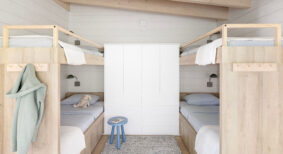Through the many social media platforms that exist today, brand promotion has never been easier. These online channels are effective for advertising and self-promotion, however the real opportunity lies in their ability to connect designers with potential clients, both locally and across the globe.
By providing information of value, sharing resources, collaborating and exchanging advice and ideas within a field of expertise, this communication builds trust and respect with potential clients, vendors and design enthusiasts, all of whom will promote and champion these brands.
This digital footprint is visible through the style of communication, type of content, level of transparency and visual imagery shared online. Attaining information has evolved with the public seeking information via Twitter and blogs, sharing images and stories through Instagram and Facebook, and collecting inspiration with applications like Pinterest and Houzz.
To effectively connect and collaborate with target clients or vendors, it is important to understand the basic attributes of the more notable platforms being used in the design community. All of these channels have analytics available to measure the effectiveness of a post, evaluate the reach and ultimately track which content is resonating with a target audience.
Founded by Kevin Systrom and Mike Krieger in October of 2010, Instagram has been ranked as the number one photo sharing platform. With more than 300 million monthly active users, Instagram is an added tool likened to sketching, rendering and technical drawings and aids to communicate concepts, which might otherwise be difficult to explain. With hashtags as specific as #yycdesign or general as #DesignInspo, finding and supplying information and inspiration has never been easier. While 90 per cent of Instagram users are under the age of 35, which leaves out a relatively large demographic of potential reach, it is likely that it will continue to be a leader in image based sharing applications.
Coming up on almost a decade, Twitter grew rapidly despite the fact it was almost impossible to explain other than “a short burst of inconsequential information.” Forging the way for real-time information sharing, this platform acts as a microblog and averages 316 million active users. With 500 million tweets being sent out daily,Twitter’s mission is “to give everyone the power to create and share ideas and information instantly, without barriers.” While users are limited to 140 characters, this practice of brevity not only creates more articulate content, it allows the design community to share bits of useful information. What was once a one-sided conversation has evolved into multi-user interaction, promoting dialogue on everything from the latest trends and feature magazine editorial to new research in universal design or a new green building material. Further, users can create an individualized news feed focused on a topic of interest or lists directed at a specific user group to gain inside information into an industry.
Created by Mark Zuckerberg in his Harvard dorm room over a decade ago, Facebook has morphed from hosting college students to more than 1.49 billion monthly active users. With the opportunity to create business pages, sell, advertise and promote content, Facebook acts much like an online advertising tool. In addition to being a better platform for posting more in-depth content, it is particularly useful for posting more informal photos, like candid behind the scene images, progress photographs or personal messages to clients.
Pinterest & Houzz
Both platforms, Pinterest and Houzz, act as virtual inspiration platforms sans corkboard and pushpins. While Pinterest features images from anything like the perfect pair of boyfriend jeans to vintages cars, Houzz is solely focused on the collection of images in the architecture and interior design industry making it more streamlined. However, both tools allow users to create thematic pin boards labeled everything from “dream house” to “restaurant design,” allowing greater insight into the direction of a project. Not surprisingly, designers are one of the number one users of both platforms, creating a playground of stylish images for clients to collect and share.
Ultimately, face-to-face interaction still remains the best form of communication. The subtle nuances of body language, cues apparent in facial recognition and the use of tone and emphasis are difficult to read via online applications. However, used efficiently and strategically alongside personal interaction and traditional marketing, online tools are incredibly effective at reaching larger audiences, growing brands and furthering education within the design community. There is awe and wonder behind creative work that deserves to be shared and used to fuel inspiration in others.
Amanda Hamilton is the founder and creative director of Amanda Hamilton Interior Design and her eponymous collection of textiles and lifestyle goods.







